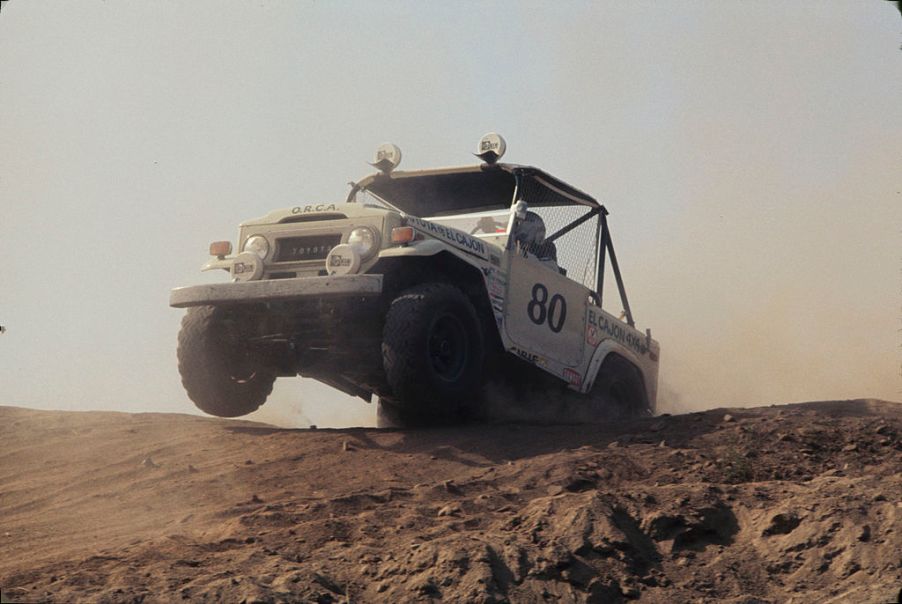
The Older Toyota FJ Series Trucks Are Practically Unbreakable
Some of the best four-wheel-drive vehicles have extreme toughness built into them. The Ford Raptor, the Jeep Gladiator, and the Toyota Tacoma all come to mind when we think of sturdy off-road trucks. But there is a historic line of 4X4 trucks that are as virtually indestructible as they are iconic: the Toyota FJ Series Land Cruisers. Let’s learn more about these awesome trucks, courtesy of The FJ Company Blog.
The history of the Toyota FJ Series
The origin of the FJ Land Cruiser goes back to 1950, the start of the Korean War. The U.S. government contracted Toyota to build 100 military vehicles that had American Jeep specifications. Toyota back-engineered the Willys-specced Jeep but also looked to the British Land Rover for inspiration.
These trucks had an F-type engine, as compared to the BJ25, which used a B-type engine. These engines were represented by “F” and “B” in the names of these models. The “J” stood for Jeep.
The ultimate result was the BJ25, which was produced from 1955 to 1984. It was larger than the American Jeep. It ran on the B-type 3.4-liter 6-cylinder engine. The B-type was based on the 207-cc engine that powered the 1930s Chevy Master Deluxe. The BJ25 was equipped part-time four-wheel drive like the Jeep.
The BJ25 also brought worldwide attention to Toyota’s efforts at making 4X4 trucks after a test driver took one of these rugged trucks up to the sixth station of Mt. Fuji.
Toyota eyes civilian buyers
Between 1950 and 1960, Toyota produced the FJ20s, which were tailored more for civilian drivers. These vehicles also made Toyota a global brand. The FJ20s had F-type engines, which were robust 3.9-liter inline sixes.
In 1960, Toyota rolled out the FJ40s. Equipped with an F-type engine and folding jump seats in the rear, buyers could select a hard-top or soft-top version as well as a shorter wheelbase.
Some of the notable versions of the FJ40s were the FJ43 which had a longer wheelbase with more space in the trunk and the FJ45, which was available as an ambulance and a pickup truck. Both were in production until 1984.
At about the same time that the FJ40s were being produced, Toyota released the BJ40s series. Created for the Japanese market, It had a B-type diesel engine. The BJ40s were the first instances of the FJ’s rear seat facing forward.
The FJ70 series was first produced in 1984 to pick up where the FJ40s left off and are still sold in Japan today. These trucks have never been sold in the U.S. Toyota offers three wheelbases for this truck: short, medium, or long. And buyers can choose between a 2-door and a 4-door version.
The last of the FJ trucks was the FJ Cruiser, which was produced from 2006 until 2014. This retro-styled SUV was very different in spirit from its predecessors. It’s comfortable and well-made, but it’s more suited for the highway than for rough trails that the earlier FJ trucks took on.
Jeep’s rival
The first FJ Land Cruiser was inspired by Jeep. The American government needed light military vehicles that operated like Jeeps but they were willing to try a cheaper option. Toyota, which was struggling in an economically-challenged post-war Japan, welcomed the chance to manufacture these vehicles. And the U.S. military ended up ordering 5,000 FJs which, in turn, helped to bring Toyota back from the brink.
Over a span of just a few years, Toyota improved the FJ to the point where it matched or surpassed the Jeep in power, quality, and offroad capability. For example, the F-type and B-type engines used by the earlier FJ Series trucks were bigger and had more displacement than the Willys MB Jeep’s inline four-cylinder engine. The 2F engine, which powered FJ trucks made from 1975 to 1988, was at 4.2 liters, was even larger and more powerful.
As the series evolved, Toyota continued to innovate with a number of configurations. This evolution ran parallel to that of Jeep’s, as the American offroader branched out with models like the Willys Jeep station wagon and truck, the Wrangler and, ultimately, the Renegade.
The Toyota FJ Series’ superb reliability
The FJ Land Cruisers‘ hardy F-type and B-type engines are renowned for their longevity. It’s fairly easy to find well-preserved models that are still running in many countries. Their transmissions are also tough and don’t wear out easily.
The trucks’ leaf-spring suspension is another testament to the FJ Series’ resiliency. Even though this kind of suspension hasn’t been commonly used since the ’70s, it’s ideal for the substantial FJ truck. It distributes the truck’s weight more evenly while avoiding the added heft that the extra parts that coil suspension requires.
The electrical system also contributes to the FJ Series’ dependability. Typically, this is a system that has many components prone to failure beyond the battery. But the FJ Series’ electrical system is sound and can handle the most brutal driving conditions.
Around the world, Toyota’s FJ Land Cruisers have enjoyed a reputation for being durable. It doesn’t matter where their owners drive them. It could be up mountainous trails, over sand dunes, or through snowy tundra, they just don’t break down. Regardless of how these trucks have been configured, they can be counted on to tackle any offroad tasks that needed doing.


